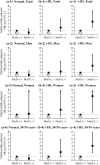Impact of metabolic syndrome on the incidence of type 2 diabetes in middle-aged Japanese individuals with impaired insulin secretion: the Saku study
- PMID: 30603313
- PMCID: PMC6224931
- DOI: 10.1007/s13340-016-0287-6
Impact of metabolic syndrome on the incidence of type 2 diabetes in middle-aged Japanese individuals with impaired insulin secretion: the Saku study
Abstract
Aims: To assess the impact of metabolic syndrome (MetS) on the incidence of type 2 diabetes in middle-aged Japanese individuals with impaired insulin secretion (IIS).
Methods: This cohort study included 1,702 individuals aged 40-59 without diabetes at baseline who underwent a comprehensive medical check-up between April 2008 and March 2009 at Saku Central Hospital. Participants were classified according to their IIS and insulin resistance (IR) status [normal, isolated IR (i-IR), or isolated IIS (i-IIS)] and MetS (presence or absence). They were followed up until March 2014. Type 2 diabetes was defined based on fasting and 2-h post-load plasma glucose concentrations and by the receipt of medical treatment for diabetes.
Results: During 7,572 person-years of follow-up, 92 individuals developed type 2 diabetes. The incidence rates (/1,000 person-years) for type 2 diabetes in the normal without MetS, normal with MetS, i-IR without MetS, i-IR with MetS, i-IIS without MetS, and i-IIS with MetS groups were 5.3, 3.7, 11.3, 24.7, 16.7, and 59.5, respectively. The multivariable-adjusted hazard ratios (HRs) and 95 % confidence intervals (CIs) for type 2 diabetes in the normal with MetS, i-IR with MetS, and i-IIS with MetS groups, relative to the normal without MetS group, were 0.52 (0.12-2.25), 3.78 (1.93-7.42), and 7.94 (3.96-15.91), respectively. Additionally, a positive association of MetS with type 2 diabetes was observed in the i-IIS group [HR (95 % CI) 3.56 (1.88-6.73)] but not in the normal and i-IR groups.
Conclusions: The prevention of MetS is important, particularly in individuals with low insulin secretion.
Keywords: Impaired insulin secretion; Metabolic syndrome; Middle age; Type 2 diabetes.
Conflict of interest statement
The authors declare that they have no conflict of interest.All procedures followed were in accordance with the ethical standards of the responsible committee on human experimentation (institutional and national) and with the Helsinki Declaration of 1964 and later revisions. Informed consent or a substitute for it was obtained from all participants before they were included in the study.
Figures


Similar articles
-
Impact of impaired insulin secretion and insulin resistance on the incidence of type 2 diabetes mellitus in a Japanese population: the Saku study.Diabetologia. 2013 Aug;56(8):1671-9. doi: 10.1007/s00125-013-2932-y. Epub 2013 May 17. Diabetologia. 2013. PMID: 23680915
-
Increase in homeostasis model assessment of insulin resistance (HOMA-IR) had a strong impact on the development of type 2 diabetes in Japanese individuals with impaired insulin secretion: the Saku study.PLoS One. 2014 Aug 28;9(8):e105827. doi: 10.1371/journal.pone.0105827. eCollection 2014. PLoS One. 2014. PMID: 25166121 Free PMC article.
-
Effect of body mass index on insulin secretion or sensitivity and diabetes.Am J Prev Med. 2015 Feb;48(2):128-135. doi: 10.1016/j.amepre.2014.09.009. Epub 2014 Nov 10. Am J Prev Med. 2015. PMID: 25442224
-
Risk and population attributable fraction of metabolic syndrome and impaired fasting glucose for the incidence of type 2 diabetes mellitus among middle-aged Japanese individuals: Aichi Worker's Cohort Study.J Diabetes Investig. 2020 Sep;11(5):1163-1169. doi: 10.1111/jdi.13230. Epub 2020 Mar 3. J Diabetes Investig. 2020. PMID: 32022993 Free PMC article.
-
Metabolic syndrome components and diabetes incidence according to the presence or absence of impaired fasting glucose: The Japan Epidemiology Collaboration on Occupational Health Study.J Epidemiol. 2017 Sep;27(9):408-412. doi: 10.1016/j.je.2016.08.015. Epub 2017 Apr 20. J Epidemiol. 2017. PMID: 28434837 Free PMC article.
References
-
- Danaei G, Finucane MM, Lu Y, Singh GM, Cowan MJ, Paciorek CJ, et al. National, regional, and global trends in fasting plasma glucose and diabetes prevalence since 1980: systematic analysis of health examination surveys and epidemiological studies with 370 country-years and 2.7 million participants. Lancet. 2011;378:31–40. doi: 10.1016/S0140-6736(11)60679-X. - DOI - PubMed
LinkOut - more resources
Full Text Sources
Miscellaneous
